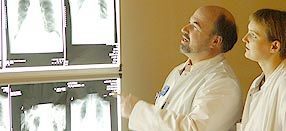by
Joan Trombetti, Writer | February 10, 2009

Dr. Jörg Hausleiter(left) of the Germany
Heart Hospital
Results published in the February 4 issue of the Journal of the American Medical Association showed that investigators involved in the Prospective Multicenter Study on Radiation Dose Estimates of Cardiac CT Angiograpy in Daily Practice I study (PROTECTION I) were encouraged by the median 12-mSv effective dose for the 1,965 patients scanned in selected one-month periods from February to December 2007. The participants were drawn from 21 academic and 29 community hospitals in Europe, the U.S., Asia, and South America.
Trial authors said they were satisfied with the results that establish a benchmark for expected dosages for assessing coronary arteries, bypass grafts, or chest pain protocols for the combined visualization of the coronary and pulmonary arteries and thoracic aorta. Trial senior researcher Stephan Achenbach, MD, director of cardiac imaging research at the University of Erlangen in Germany said the lesson of the trial is that a lot of things can be done to lower radiation, and that it was a very positive trial showing that something can be done about radiation.
At the same time, according to first author Dr. Jörg Hausleiter of the Germany Heart Hospital in Munich, dosage was highly variable. The per-center median dose length product (DLP), a measure of integrated dose during an entire CT exam, ranged from 331 mGy/cm to 2146 mGy/cm. Hausleiter said that dose reduction strategies had a major effect on patient exposure with the except of tube current modulation, dose reduction strategies wer not generally used. Automatic exposure control tube current modulation, which resulted in a 25% DLP reduction, was applied for 73% of patients.



Ad Statistics
Times Displayed: 656
Times Visited: 5 Fast-moving cardiac structures have a big impact on imaging. Fujifilm’s SCENARIA View premium performance CT brings solutions to address motion in Coronary CTA while delivering unique dose saving and workflow increasing benefits.
The use of tube current and kVp modifications according to patient weight and height using an automatic exposure control feature depended on the make and model of equipment.
More than half of Philips and Toshiba 64-slice scanner users employed automatic exposure control. Utilization was lower for GE (32.3%) and Siemens (21.3%)64-slice scanner users. About 45% of Siemens dual-source scanner users used the feature. A 100-kV tube setting produced a 46% dose reduction and was used for 5% of cases, though clinical trials establishing its benefits are new, according to coauthor Cynthia McCollough, a professor of radiological physics at the Mayo Clinic in Rochester, MN. She said that many technologists have yet to learn you have to turn up the mAs to maintain good image quality when you turn down the kVs. She added that sequential scanning, a prospective ECG-triggered sequence that halts exposure outside a specific time window, was credited with a 78% dose reduction and performed for 6% of cases. It also has not until recently been evaluated in published clinical trials.
There were also several other independent factors including:
-patient weight (relative effect on DLP, 5%)
- absence of stable sinus rhythm (type of heart rhythm, 10% effect)
-scan length (a 1-cm increase in the scan length was associated with a 5% increase in DLP)
-facility experience in cardiac CT (1% reduction)
-cardiac CTA patient volume
-type of 64-slice CT system (for highest versus lowest dose system, 97% effect)
Patient dosages were lowest in the U.S. and Canada, Germany, and Western Europe. They were higher in East Asia and Australia, the Middle East, and South America.
Read more at:
https://www.dotmed.com/news/story/8097/

